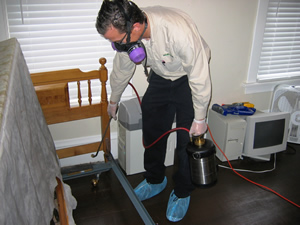Professional Bed Bug Exterminator Near Me: DC Exterminator Provider
Professional Bed Bug Exterminator Near Me: DC Exterminator Provider
Blog Article
Checking Out the Science Behind Bed Pest Warm Treatments as a Lasting Pest Administration Technique
One such approach that has actually acquired grip in current years is the usage of warm therapies to battle bed pest invasions. The complexities of just how warmth effectively removes bed insects and the broader effects for sustainable parasite monitoring methods make this a subject worth exploring better.
Bed Pest Heat Therapy Refine

Thermal Fatality Factor for Bed Pests
Revealing bed insects to raised temperatures past their thermal resistance array is crucial for accomplishing efficient obliteration in warm treatment processes. The thermal death factor for bed pests describes the temperature level at which these parasites can not make it through. Study shows that bed bugs start to die when subjected to temperatures over 113 ° F(45 ° C) for a sustained period. As the temperature raises, so does the mortality price of bed insects. At around 118 ° F(48 ° C ), bed bugs start to die swiftly, with a mortality rate of virtually 99% within minutes of direct exposure. This shows the level of sensitivity of bed bugs to heats and highlights the efficiency of warm treatments in eradicating invasions. By reaching and keeping temperature levels over the thermal fatality factor for bed bugs, parasite monitoring specialists can ensure detailed elimination of bed pest populaces, including hard-to-reach areas where chemical treatments might be less effective. Recognizing the thermal death point for bed pests is necessary for carrying out effective warm treatment strategies and achieving lasting pest management outcomes.
Advantages of Warmth Treatments
Having actually developed the crucial thermal death factor for bed bugs, it is crucial to currently discover the substantial benefits that warmth treatments offer in effectively eliminating these resistant parasites. When contrasted to standard chemical methods, warm treatments existing numerous vital benefits. One of the key advantages is that heat can permeate deep right into fractures and gaps where bed bugs conceal, making certain that also one of the most hard-to-reach areas are heated to deadly temperatures. This thorough technique not just eliminates live insects but likewise targets bed bug eggs, preventing future problems.
In addition, warm treatments are non-toxic and eco friendly, making them a sustainable pest administration approach. Unlike chemical pesticides, warmth treatments do not leave damaging deposits that can pose threats to human health or the setting. This facet is particularly essential in delicate environments such as hospitals, institutions, and additional hints suburbs where chemical use might not be desirable.
In addition, heat therapies have a high success price in eliminating bed pest invasions in a solitary therapy, minimizing the need for multiple sees and reducing disturbance to passengers. This efficiency not only conserves time and cash however additionally supplies comfort to those handling bed insect troubles.
Efficiency of Heat Therapy

Research study research studies have actually continually shown the effectiveness of heat treatments in achieving a high rate of bed insect mortality. Appropriately carried out heat treatments can reach all the splits and crevices where bed bugs might be nurturing, ensuring a thorough approach to elimination. Warmth treatments have actually the added check my site advantage of eliminating bed insect eggs, which are often immune to typical chemical therapies. Overall, the efficiency of warmth therapies in getting rid of bed insect invasions makes them a dependable and sustainable pest administration strategy.
Sustainable Pest Administration Advantages
Executing sustainable pest administration techniques provides long-lasting advantages for both the setting and public health. By making use of techniques such as warm therapies for bug control, we can lower the dependence on harmful chemical pesticides that can have adverse impacts on environments and human health and wellness - bed bug treatment. Sustainable parasite administration methods help in preserving biodiversity by targeting certain pests without damaging non-target microorganisms, thereby keeping a balanced environment
Moreover, sustainable bug monitoring methods add to the total wellness and well-being of the general public. By lessening exposure to toxic chemicals used in typical pest control approaches, warmth therapies offer a safer alternative for parasite administration in domestic, industrial, and public rooms. This reduction in chemical usage additionally aids in avoiding pesticide residues from polluting air, water, and soil, protecting environmental quality.
Conclusion
In verdict, bed pest heat therapies have been revealed to be a lasting and effective parasite monitoring technique. The thermal fatality factor for bed bugs makes them at risk to warm therapies, which have numerous advantages over typical chemical therapies. The effectiveness of warm treatments in eliminating bed pest invasions while minimizing ecological effect highlights the potential of this technique as a lasting remedy for parasite control.
The bed bug warm therapy procedure entails raising the temperature within infested article locations to a degree that effectively removes bed pests and their eggs. By getting to and keeping temperatures over the thermal fatality point for bed pests, bug monitoring specialists can ensure comprehensive elimination of bed insect populaces, consisting of hard-to-reach locations where chemical treatments might be less effective. One of the key benefits is that heat can permeate deep into crevices and fractures where bed bugs hide, making certain that also the most hard-to-reach areas are heated to lethal temperatures. Unlike chemical treatments that may leave behind resistant populaces, heat treatments use a environmentally pleasant and safe service that can permeate deep right into furniture, wall surfaces, and various other hard-to-reach areas where bed bugs conceal.
The thermal fatality point for bed bugs makes them vulnerable to warmth therapies, which have various advantages over typical chemical therapies.
Report this page